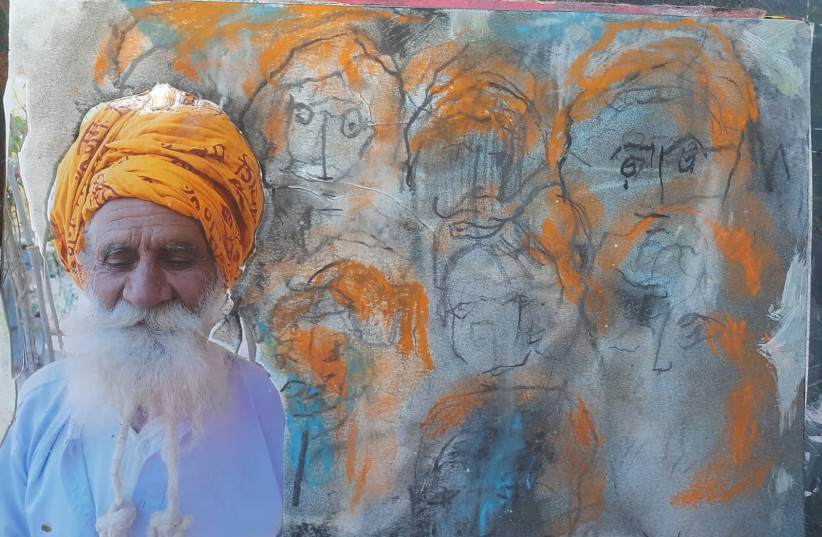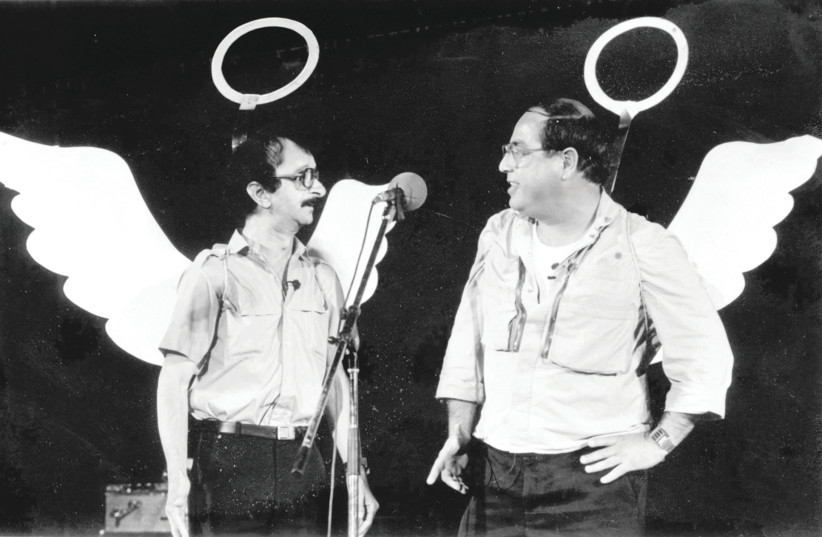Israeli artist Amir Gurevich, still painting while nearly blind

An exhibition of Gurevich’s artwork titled “Minimal Sight – Maximum Hope,” curated by Yotam Oren, was displayed recently at Gallery 58 in the Holon Municipality building.
After decades of working in the art world and creating huge backdrops for popular Israel TV productions such as Nikui Rosh, Ritch Ratch and Hopa Hey, painter and artist Amir Gurevich has lost almost all of his sight. Nevertheless, he has persevered, and his disability has not prevented him from continuing to create works of art.
An exhibition of Gurevich’s artwork titled “Minimal Sight – Maximum Hope,” curated by Yotam Oren, was displayed recently at Gallery 58 in the Holon Municipality building.
“I feel the need to create every day,” Gurevich explains. “I keep myself busy making art at least four hours every day. There’s always a bit of laughter, enjoyment, as well as crying, lots of crying. Sometimes I paint things that are very difficult to paint. On the back of such a painting, I write, ‘This was difficult for me to create. Today I didn’t see anything.’ Sometimes I like to express these difficulties in words on the back of the canvas.”
Gurevich, 82, was born in Holon and was honored with the Yakir Award from his hometown. He’s had many interesting stages in his career as an artist. In 1960, he began studying art at the Avni Institute of Art and Design in Tel Aviv. Later, he moved to the US to study at the School of Drama at Yale University, and then did an internship in which he worked in backdrop and costume design for Broadway shows.
“I was lucky enough to be part of the team that created backdrops for After the Fall by Arthur Miller. In fact, Arthur Miller himself showed up as we were assembling the backdrops to take a look at them. I’ll never forget turning around and seeing him standing there. My eyes went big, and I was so shocked I couldn’t move. I was young then and never would have contemplated trying to talk to him. Other famous people, such as Peter Ustinov and Sidney Poitier, also showed up at various times. It was such an exciting time in my life.”
Another time, though, when Marc Chagall walked into the studio, Gurevich plucked up the courage and approached him. “Chagall arrived at the studio while we were preparing the backdrop for the premiere night of The Magic Flute,” Gurevich recalls. “I gathered up all the courage I could, and I went to talk to him.
“At the time, my English sounded more like Yiddish, and he responded to me, saying, ‘Let’s talk in Yiddish.’ So we began speaking in Yiddish, and then at some point switched to Russian.
“I asked him if he’d be so kind as to give me his autograph. He responded, saying, ‘Go downstairs to the shop and buy a postcard of one of my works, and I’ll sign that.’ I ran as fast as I could, but the store was closed. Sadly, I never did manage to get his autograph,” he laments.
IN 1968, when Israel TV was established, Gurevich returned to Israel and began working as the TV station’s senior backdrop designer. “At the time, Prof. Elihu Katz and Uzi Peled had traveled to the US in search of individuals with experience overseas who could help found Israel’s TV station,” Gurevich explains.
“They interviewed me, then I received a telegram that they were waiting for me. Over the years, I designed backdrops for many Israel Song Festivals, and I also worked with Nissim Aloni at the Seasons Theater, as well as preparing backdrops for a lot of movies.”
What are your most memorable moments from those years?
Nikui Rosh was a fantastic satire show. Moti Kirschenbaum would show up with a script that had been completed just moments before we went on the air. I would sit down with the design crew and we would brainstorm what backdrops would work for each scene, things that we could put together with just a few moments’ notice.
I would then rush down to the carpentry studio, which was staffed mostly by Bezalel students, and they’d prepare something on the spot. Only once the live filming was taking place could we sit back and watch to see if what we’d created was actually appropriate for the scenes. Most of the time, it was fine.
During the two weeks between filming sessions, we worked hard, planning what we’d create, but there were always so many last-minute changes. Sometimes we were even still changing or adding things during the filming. Nikui Rosh was awarded the Israel Prize, and I received a grant to intern at German TV in Munich, which was already broadcasting programs in color.
What do you remember from working on the TV show ‘Hopa Hey’?
We would drive around from one location to another all over Israel. We’d arrive at our filming location and begin putting together the backdrops outdoors, and not in the studio. Our crew included a backdrop designer, a technical person, a photographer and a designer.
We were a very tight staff and really enjoyed working together. I became especially close to Uzi Hitman, who unfortunately passed away in 2004. We had so many amazing conversations. Everyone loved him, and he loved everyone. He had such a dazzling smile and always spoke so positively with every person he came across. I also loved working with Yonatan Miller, who played whatever instruments were needed.
From his time working on the TV show Ritch Ratch, Gurevich recalls working with the show’s producer Tzlila Roz, who had been an editor for TV Channel 1 since its inception. “Tzlila really understood how to work with the kids and the team of counselors who taught the kids how to be TV stars,” Gurevich says. “To this day, I still remember the Hopa Hey opening song, of course. For that show and for Ritch Ratch there were full albums, and a picture of me with Uzi Hitman and Yonatan Miller was featured on the album covers.
“One of the first TV programs on Israel TV was a quiz show called Zaphnat Paneah, starring Yigal Yadin. In the show, Yadin is seen with a background designed as the interior of a house. Many people thought he was talking from his real home and commented that he had such a nice house. Of course, as the designer of that backdrop, this was a huge compliment for me.
“In 1969, on the day the first astronauts landed on the moon, we filmed a humorous version of the moon landing. In addition, that day was also the brit milah [circumcision] of my oldest son, Amit. When the mohel [the person who performs a circumcision] arrived, he told us he’d seen the moon landing episode and suggested we name our son Moon or Apollo.”
GUREVICH, WHO is married to Raya, has three children and a good number of grandchildren. In 1989, he began working for an IDF Intelligence unit. He retired in 2006 but kept working within the Israeli defense industry until the COVID pandemic broke out.
In March 2021, Gurevich lost most of his sight due to an illness. He is completely blind in one eye and has a little vision in the other, which he took advantage of to paint the 45 works displayed in his recent exhibition. These works are based on photographs sent to him from his colleagues in the defense establishment.
His wife printed the photographs, and then Gurevich cut out parts of the photographs that interested him and used them as his compositions, along with oil pastels, gouache paint, water, charcoal and other materials.
“I have been planning this exhibition in my mind for 30 years,” Gurevich says with a smile. “When I was working for the defense establishment, everything I did was confidential. Finally, I’m able to show my artwork publicly. It’s important for me to demonstrate that it’s still possible to create art, even if you have a disability. I volunteered with IDF soldiers at Tel Hashomer Hospital who have combat PTSD, helping them create works of art.
“It was from these experiences that I understood the difficulty of creating something when you are disabled. I too have continued to create despite my disability because making art is soothing for my soul.”
Translated by Hannah Hochner.
Jerusalem Post Store
`; document.getElementById("linkPremium").innerHTML = cont; var divWithLink = document.getElementById("premium-link"); if (divWithLink !== null && divWithLink !== 'undefined') { divWithLink.style.border = "solid 1px #cb0f3e"; divWithLink.style.textAlign = "center"; divWithLink.style.marginBottom = "15px"; divWithLink.style.marginTop = "15px"; divWithLink.style.width = "100%"; divWithLink.style.backgroundColor = "#122952"; divWithLink.style.color = "#ffffff"; divWithLink.style.lineHeight = "1.5"; } } (function (v, i) { });


